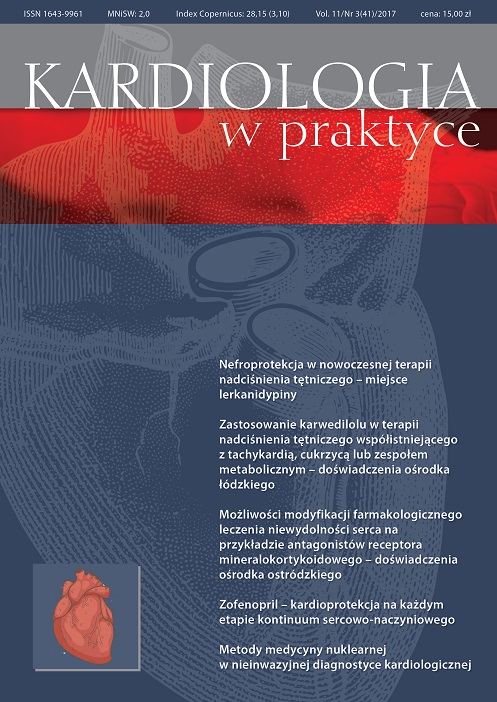Nefroprotekcja w nowoczesnej terapii nadciśnienia tętniczego – miejsce lerkanidypiny Artykuł przeglądowy
##plugins.themes.bootstrap3.article.main##
Abstrakt
Leczenie chorego z nadciśnieniem tętniczym i upośledzoną funkcją nerek to ciągle wyzwanie dla lekarza praktyka. Celem jest przede wszystkim skuteczna, ścisła kontrola ciśnienia tętniczego, co przekłada się na ochronę przed progresją nefropatii i w konsekwencji może poprawić rokowanie w tej bardzo zagrożonej populacji. W pracy przedstawiono aktualne miejsce lerkanidypiny, oryginalnego leku zaliczanego do III generacji dihydropirydynowych antagonistów wapnia, w farmakoterapii nadciśnienia tętniczego i prewencji subklinicznych powikłań narządowych nadciśnienia tętniczego, takich jak albuminuria i przewlekła choroba nerek.
Pobrania
##plugins.themes.bootstrap3.article.details##

Utwór dostępny jest na licencji Creative Commons Uznanie autorstwa – Użycie niekomercyjne 4.0 Międzynarodowe.
Copyright: © Medical Education sp. z o.o. This is an Open Access article distributed under the terms of the Attribution-NonCommercial 4.0 International (CC BY-NC 4.0). License (https://creativecommons.org/licenses/by-nc/4.0/), allowing third parties to copy and redistribute the material in any medium or format and to remix, transform, and build upon the material, provided the original work is properly cited and states its license.
Address reprint requests to: Medical Education, Marcin Kuźma (marcin.kuzma@mededu.pl)
Bibliografia
2. Kaplan N.M.: Nadciśnienie tętnicze – aspekty kliniczne. Wydawnictwo Czelej, Lublin 2006.
3. Tykarski A., Narkiewicz K., Gaciong Z. et al.: Zasady postępowania w nadciśnieniu tętniczym – 2015 rok. Wytyczne Polskiego Towarzystwa Nadciśnienia Tętniczego. Nadciśnienie Tętnicze w Praktyce 2015; 1: 1-70.
4. NKF K/DOQI Clinical Practice Guidelines for chronic kidney disease: evaluation, classification and stratification. Am. J. Kidney Dis. 2002; 39(supl. 1): S1-S266.
5. Więcek A., Chudek J.: Nefropatia nadciśnieniowa. W: Pasierski T., Myśliwiec M., Imiela J. (red.): Kardionefrologia. Medical Tribune Polska, Warszawa 2007.
6. Wyrzykowski B.: Nadciśnienie tętnicze. Patofizjologia i terapia. Via Medica, Gdańsk 1999.
7. Culleton B.F., Larson M.G., Wilson P.W. et al.: Cardiovascular disease and mortality in a community-based cohort with mild renal insufficiency. Kidney Int. 1999; 56: 2214-2219.
8. Leoncini G., Viazzi F., Parodi D. et al.: Creatinine clearance and signs on end-organ damage in primary hypertension. J. Hum. Hypertens. 2004; 18: 511-516.
9. Campese V.M., Mitra N., Sandee D.: Hypertension in renal parenchymal disease: why is it so resistant to treatment? Kidney Int. 2006; 69(9): 967-973.
10. Coresh J., Wei G.L., McQuillan G. et al.: Prevalence of high blood pressure and elevated serum creatine level in the Unites States: Findings from the third National Health and Nutrition Examination Survey. Arch. Intern. Med. 2001; 161: 1207-1216.
11. Sarafidis P.A., Li S., Chen S.C. et al.: Hypertension awareness, treatment, and control in chronic kidney disease. Am. J. Med. 2008; 121: 332-340.
12. Wright J.T., Bakris G., Greene T. et al.: Effect of blood pressure lowering and antihypertensive drug class on progression of hypertensive kidney disease. Results from the AASK trial. JAMA 2002; 288: 2421-2431.
13. Ruggenenti P., Perna A., Loriga G. et al.: Blood-pressure control for renoprotection in patients with non-diabetic chronic renal disease (REIN-2): multicentre, randomised controlled trial. Lancet 2005; 365: 939-946.
14. Leoncini G., Viazzi F., Rosei E.A. et al.: Chronic kidney disease in hypertension under specialist care: the I-DEMAND study. J. Hypertens. 2010; 28(1): 156-162.
15. Zdrojewski Ł., Król E., Rutkowski B. et al.: Chronic kidney disease in Polish elderly population aged 75+: results of the WOBASZ Senior Survey. Int. Urol. Nephrol. 2017; 49(4): 669-676.
16. Załuska W., Klinger M., Kusztal M. et al.: Rekomendacje Grupy Roboczej Polskiego Towarzystwa Nefrologicznego dotyczące kryteriów leczenia dializami pacjentów z powodu schyłkowej niewydolności nerek. Nefrol. Dial. Pol. 2015; 19: 6-11.
17. Król E., Rutkowski B.: Przewlekła choroba nerek – klasyfikacja, epidemiologia i diagnostyka. Forum Nefrologiczne 2008; 1(1): 1-6.
18. Foley R.N., Parfrey P.S., Sarnak M.J.: Clinical epidemiology of cardiovascular disease in chronic renal disease. Am. J. Kidney Dis. 1998; 32: S112-S119.
19. Kostka-Jeziorny K., Tykarski A., Dzida G. et al.: Lerkanidipina w leczeniu nadciśnienia tętniczego i jego powikłań sercowo-naczyniowych. Nadciśnienie Tętnicze 2012; 4: 216-223.
20. Sabbatini M., Leonardi A., Testa R. et al.: Effects of dihydropyridine-type Ca antagonists on the renal arterial tree in spontaneously hypertensive rats. J. Cardiovasc. Pharmacol. 2002; 39: 39-48.
21. Della Vestra M., Pozza G., Mosca A. et al.: Effect of lercanidipine compared with ramipril on albumin excretion rate in hypertensive type 2 diabetic patients with microalbuminuria: DIAL Study (diabete, ipertensione, albuminuria, lercanidipina). Diabetes Nutr. Metab. 2004; 17: 259-266.
22. Robles N.R., Ocon J., Gomez C.F. et al.: Lercanidipine in patients with chronic renal failure: the ZAFRA study. Ren. Fail. 2005; 27: 73-80.
23. Robles N.R., Romero B., de Vinuesa E.G. et al.: Treatment of proteinuria with lercanidipine associated with renin-angiotensin axis-blocking drugs. Ren. Fail. 2010; 32; 192-197.
24. Robles N.R., Calvo C., Sobrino C. et al.: Lercanidipine valuable effect on urine protein losses: the RED LEVEL study. Curr. Med. Res. Opin. 2016; 32(supl. 2): 29-34.
